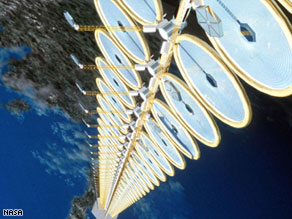"A single kilometer-wide band of geosynchronous Earth orbit experiences enough solar flux in one year to nearly equal the amount of energy contained within all known recoverable conventional oil reserves on Earth today."
 The study also concluded that solar energy from satellites could provide power for global U.S. military operations and deliver energy to disaster areas and developing nations.
The study also concluded that solar energy from satellites could provide power for global U.S. military operations and deliver energy to disaster areas and developing nations.
"The country that takes the lead on space solar power will be the energy-exporting country for the entire planet for the next few hundred years," Miller said.
But a number of obstacles still remain before solar satellites actually get off the ground, said Jeff Keuter, president of the George C. Marshall Institute, a Washington-based research organization. "Like any activity in space, there are enormous engineering challenges," he said.
- One major barrier is a lack of cheap and reliable access to space, a necessity for launching hundreds of components to build what will be miles-long platforms.
- Developing robotic technology to piece the structures together high above Earth will also be a challenge.
- Then there is the issue of finding someone to foot what will be at least a billion-dollar bill.
"It will take a great deal of effort, a great deal of thought and unfortunately a great deal of money," Keutersaid. "But it is certainly possible."
And Miller, of the Space Power Association, said he thinks it will be possible in the next 10 years.
"We could see the first operational power satellite in about the 2020 time frame if we act now," he said.
- "Bee, eye, ell, ell, eye, oh, in"
- "Tea, are, eye, ell, ell, eye, oh, in"?
Because, I accept that a billion dollars is more money than I personnally have in my change jar, but a billion dollars is like the proveribial droppings of a single bat in a cave full of guano.
"The country that takes the lead on space solar power will be the energy-exporting country for the entire planet for the next few hundred years."
An Economics major I am not; but the energy exports for an entire planet for 300 years seems a fairly generous return on a teensy-weensy billion dollar investment. Something doesn't make sense here:
NASA and the United States Department of Energy studied the concept throughout the 1970s, concluding that although the technology was feasible, the price of putting it all together and sending it to outer space was not.
"The estimated cost of all of the infrastructure to build them in space was about $1 trillion," said John Mankins, a former NASA technologist and president of the Space Power Association. "It was an unimaginable amount of money."
NASA revisited space solar power with a "Fresh Look" study in the mid-'90s but again found that even though the technology needed for the satellites had become significantly cheaper and more advanced, the up-front costs were still prohibitive, Mankins said. By 2002, the project was indefinitely shelved -- or so it seemed.
So, we went from a trillion dollars in the 1970's, to a "prohibitive" cost in the 90's, to the somewhat un-impressive billion dollars in the aughts.
Anyone want to wager we'll be sunning our electricity within the lifespan of a thirty-something?

No comments:
Post a Comment